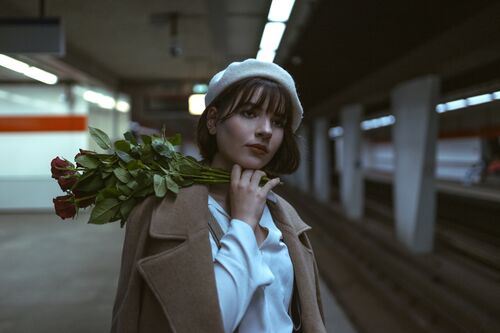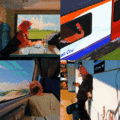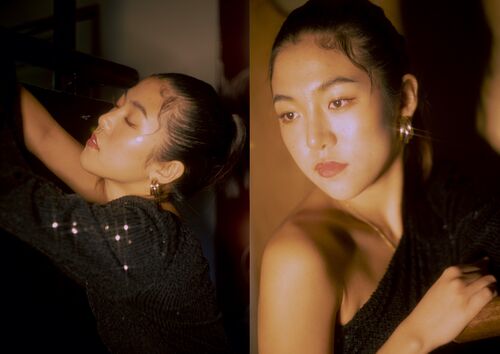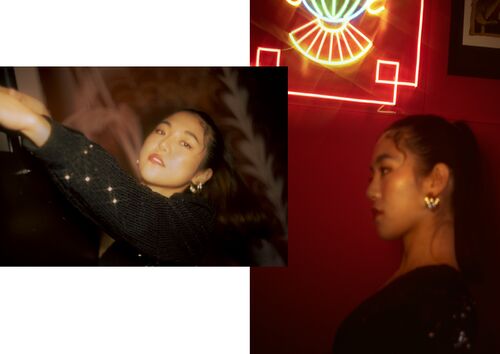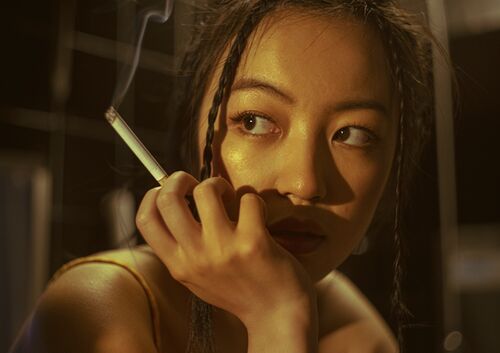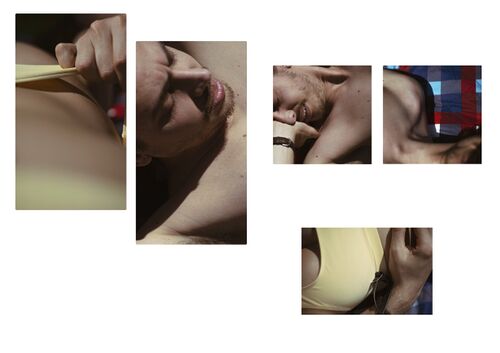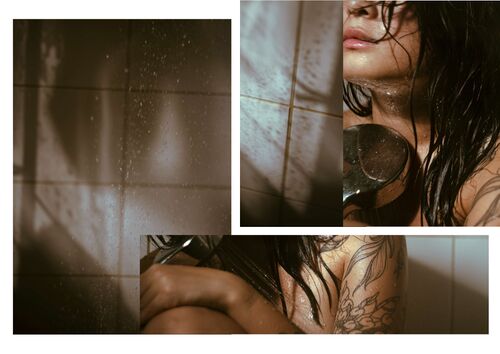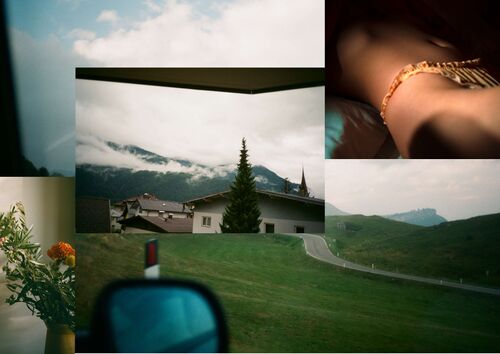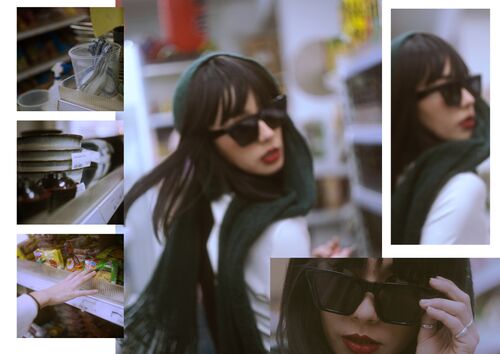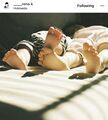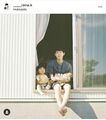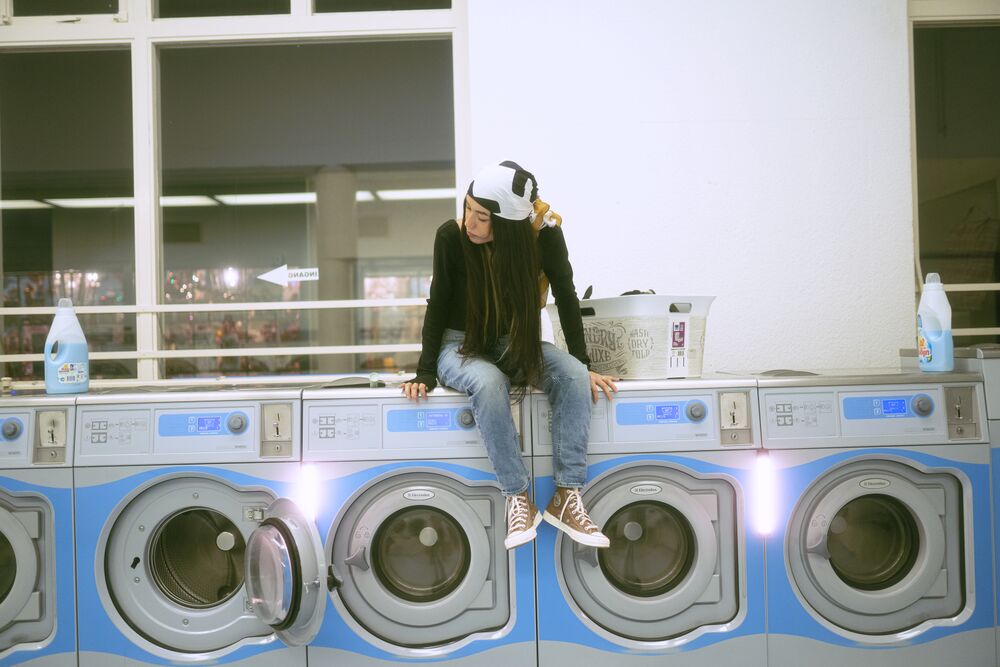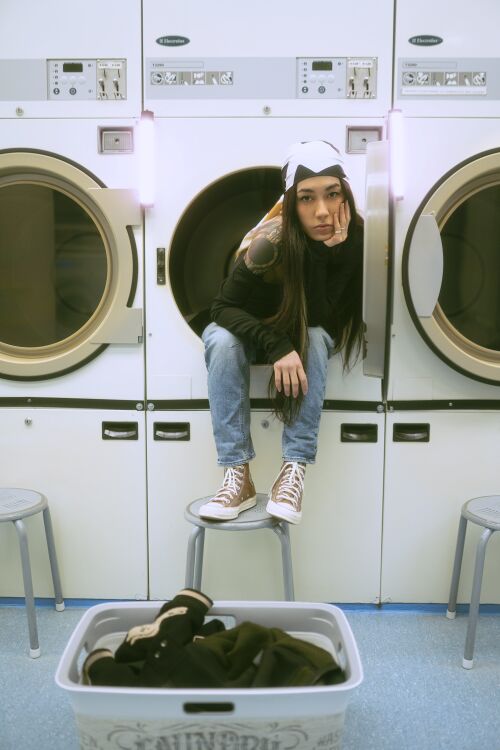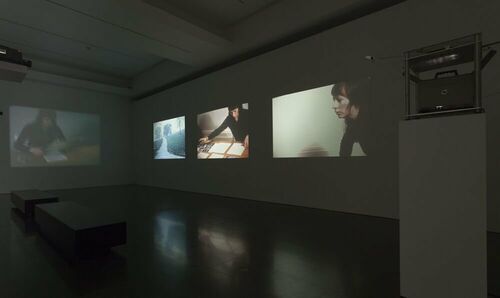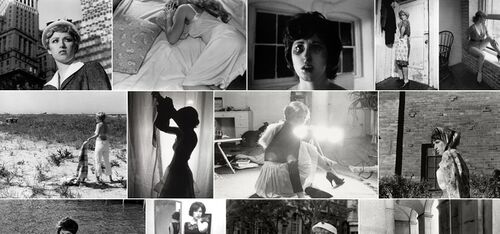MathildeThesisDraft: Difference between revisions
MathildeNai (talk | contribs) |
MathildeNai (talk | contribs) |
||
| Line 56: | Line 56: | ||
These photos, to me, are a perfect example of an “in the moment” photo, because it doesn’t feel like the model is specifically there to be photographed. The Photographer is documenting a moment. This is because the model has this disconnected look from the photographer. So while she is aware of him; it’s almost like her attention isn’t on specifically taking this photo. | These photos, to me, are a perfect example of an “in the moment” photo, because it doesn’t feel like the model is specifically there to be photographed. The Photographer is documenting a moment. This is because the model has this disconnected look from the photographer. So while she is aware of him; it’s almost like her attention isn’t on specifically taking this photo. | ||
Revision as of 12:38, 17 February 2022
Untitled
A study on slice of life photographs.
Toward Slice of life works
In the previous work I did before joining PZ I’ve experimented a lot with creating cinematic scenes, almost like a screenshot out of a movie. These examples below were created with a scene in mind where the character in the story is either on their way somewhere or waiting for something. Back then I created the images with the ultimate goal of wanting to achieve this slice of life type of storytelling that is the goal of the thesis I am writing, however I felt that they lacked the narrative depth that I am currently in search of.
While these images are no longer representative of my current work and research, the underlying goal that I was trying to create is still an ongoing journey for me.
The dictionary definition of Slice of Life is: "a realistic representation of everyday experience in a film, play, or book." But what does it mean to me? To me slice of life work romanticises the mundane. I would see it as an analysis in which the work would highlight a "boring" scenario but find a way to highlight a certain beauty or calmness in that moment. Almost like a mindfulness practice of the photographer. [a) One look Susan Sontag's meaning of Slice of life, On Photography. b) look at the idea of the 'everyday' in culture and art. [Steve asks: In On Photography Susan Sontag mentions a type of photo which is``a thin slice of space [and] time (Sontag 1979). Please unpack what Sontag means by that term and discuss it in relation to your own use of the term 'slice of life' photography]]
One of the first experiments that I did was an analysis on memory.
I wanted to recreate moments of intimacy that provoke and convey emotion. These works would, too, have a "slice of life" element to them; by which I mean, universally relatable, specific moments that we all share. This concept also touched on the subject of mindfulness; these memories would be shot and composed in the way that I remember them: in fragments and details of a moment that comprise a story. Like being transported back to that moment.
The example below is a good example of what the memories would look like. They are scenarios that are all part of a bigger journey. It is telling is how the character experiences her journey. It is a relatable moment with which we can empathise and almost transport ourselves into that scenario and how we would feel ourselves.
[S: is this a 'cinematic experience'? Unpack what is happening here- unpack what the relation between cinema and memory are for you. Are your photos cinema stills? If so, what does it mean to make a cinema still? Are What is the relation between 'slice of life' pictures, movie stills and your photos?]
Before I started experimenting with the memories; I focussed on style. Using the vocabulary of photography and cinema I tried to establish what this changes in my narrative. What does lighting do to a certain mood of the photograph? What does composition do with the intensity of a scene? And what do colours tell us about a moment?
[FOTO TAYLOR WEGKIJKEN]
This wasn’t supposed to have the look of a cinema still, the purpose of this photo was to make it look like an analog clubbing snapshot.
The model is on a night out, she is wearing a glittery dress. Her ponytail is a very polished one with the hair embellishments. It’s very much a clubbing outfit.
Harsher lighting that was supposed to imitate a harsh flash from the camera itself. There’s a harsh light beam on the side of her face; almost the product of using a fast flash. The light it not supposed to be perfect, it’s supposed to capture the subject quickly and in the moment. I also used a star filter in order to place an emphasis on the glitter and because it gives the photo a more 80’s feel.
I used a digital camera with the use of a helios lens. This lens doesn’t have autofocus and tones down the colours a little bit, creating a dreamier look. This use of forced manual focus, allows me feel like I’m using my own analog camera while still shooting digital; it’s kind of like I’m trying to find a shooting style that mixes these two elements of analog and digital shooting styles.
The pose is very disconnected to the camera. She’s not noticing that someone is photographing her. Her eyes are closed; she is very much basking in a private feeling of euphoria. She is feeling the music or the drugs. She is either not present at all or too present.
[FOTO TAYLER, MOVEMENT]
This image has the same imaged story as the last one, however there’s more movement. The model is noticing the camera, but it feels like she’s still not entirely making contact with the camera. She has a dreamy, disconnected look in her eyes.
The focus is not entirely on her face, but a piece of arm just in front of it. This implies movement; as if she swung backward as the photographer was taking the photo.
These photos, to me, are a perfect example of an “in the moment” photo, because it doesn’t feel like the model is specifically there to be photographed. The Photographer is documenting a moment. This is because the model has this disconnected look from the photographer. So while she is aware of him; it’s almost like her attention isn’t on specifically taking this photo.
These images were greatly inspired by the style of the movie "In the Mood for Love" By Wong Kar wai. This film a particular colour range; a yellow-greenish, mostly warm toned aesthetic with a high contrast and yet a softness to it. I will also draw on the influence of asian analog photographers who use a similar aesthetic of this grainy, green toned, nostalgic aesthetic. With this style, I want these images to put the viewer in a particular nostalgic place.
These images were shot digitally and colour graded and lit to have an analogue and cinematic blend style. This promotes, to me, the best of both worlds; combining my digital shooting method with the style and nostalgia of an analog look. I want these photographs to have a feeling of being a quick snapshot while at the same time being a little too dreamy and stylised to create the feeling of it being a memory that is romanticised.
Then I moved on to the creation of the actual 'memories'.
[these images are 'stacked' Why? What happens if you arrange these images in a series, how do you read them as narrative? Lt's talk through what different experiences the viewer has with different arrangements of these images.]
What Fragments and details of a moment pieced together to create a larger story. These ‘collages’ are works that show how I remember moments; in small and intimate fragments that together create the whole memory. I wanted them to have an intense and intimate feeling to it by taking details and almost vague composition in order for the audience to have to guess what is happening. In a way inviting active thought and fantasy to the work. By also incorporating the darker/moodier style of the my previous style experiment; I wanted to create a bittersweet memory that is focussed on intimacy. How By using intimate and/or vague compositions, I tried to create a sense of wonder in the audience. Combining these in a couple of different ways, I wanted to see what the image would tell as a collage. By three out of four of the examples, I used myself or my boyfriend as a foundation in order to warm up to taking these intimate compositions and seeing if the work actually made the impact on me that I wanted. In the fourth image (in the supermarket) I used the Helios lens, that is only focussed manually, and shot my model in a way that conveyed movement and out of focus. A blurry memory. Why This is the foundation on which I wanted to build my project, exploring more within the realm of intimacy starting with myself as a way of warming up to these intimate compositions. I thought a lot about wanting to convey intimacy and emotion in my work. My first thought on these themes was memories because I felt like having lived life, remembering and having experiences and looking back at them, reminiscing, can be a very intimate and emotional experience. However as I made the work I started to wonder if this is really the direction I wanted to go in.
My first qualm about this work was; while I like the style that I was drawing my inspiration from, I did not like that I shoved my work into a very depressing palette and aesthetic. While making the experiments about the memories I wondered if this represented me right now, or if it was an echo from the work and style that I started out with. I felt like keeping up with this style stunted my possible growth and development as a photographer.
My goal at first was to make memories that are universally relatable in an attempt to make anyone feel the emotions of that particular moment, however I felt like that foundation would be very removed from me as a person and what makes my work interesting is because it’s my work in particular. So how would I make my work more hyper personal? What makes my work MINE?
Asking myself the question "Why do I want to make it?" more clearly helped me inch closer to what I really want to make and how I want to make it.
Why do you want to make it?
I have always been moved by "slice of life" type images and artworks, there is something poetic [what does that term mean to you?]about a piece of artwork that shows you a normal everyday scenario that you are not a part of and can still give that feeling of having been there. It gives me a feeling of now-ness while never actually having experienced that particular moment. Examples of these kinds of moments in the movies Totoro and Kiki's Delivery Service below, in which an absolutely mundane moment is captured, however I am transported to relaxing, stress free summer days.
Another big reason I want to create this type of art is because slice of life Anime was a big part of my escapism sources in childhood. They were essentially a coping mechanism for my younger self to deal with an unstable environment by mentally transporting myself into different, more stress free and wholesome worlds.
Going back to this realisation and ultimately accepting it as my foundation for how I view art, has made me realise I want to go back to these inspirations and use my childhood motivations as the source for my work: romanticising the mundane.
After coming to this realisation I also found my interest in the dark and moody aesthetic dwindle and finding a new interest in the light and summery color palette of Ghibli. A movie that is very in line with this slice of life, summer and stress free aesthetic was the movie "Sideways" by Alexander Payne, in which two friends travel to wine country to enjoy a relaxing and intellectually stimulating holiday.
I also became aware of and interested in Japanese analog photographers, who also use this lighter style and palette that studio Ghibli uses (Which may or may not be in correlation to one another). I found two photographers, Kuji Rena (2) and Iwakura Shiori (3), that embody this aesthetic in their work quite well.
The reason these works speak to me is not only the style which are aesthetically very much in line with the Ghibli style, but also because they have a quiet dignity to them. They are subtle and personal and are a perfect example of the romanticisation of the mundane. It's seeing the beauty in the little moments and enjoying them to the fullest. Celebrating what is most important in life: the joy of living, whenever and whatever we are doing.
And while celebrating the joy of living might be one of the most "Live, laugh, love" things to say; to me this new direction is a very personal one because anxiety, depression and darkness have been a big part of my life. And thus I am not surprised the dark and moody style was once my reality, because that is how I viewed the world. Now, with me healing mentally, I am able to appreciate and see the beauty of life and suddenly looking to experiencing it; and mindfulness is a big part of that.
And so: Slice of life, romanticising the mundane, appreciating the moment, being mindful is the direction I want to take my work in. Snapshots rather than film stills. The reason I am stepping off the "film still" concept is because I feel that force my work in a more anti-personal direction, because it is a rule that the model would not be able to interact with the camera.
The first experiment that I did for this was a series in a washing room:
What These images show us a scenario of someone in a washing room; doing your laundry is mundane, but it doesn’t have to be. While the second image is more of a fashion type photo, which makes the moment more glamorous, the first one feels like a very in-the-moment snapshot of someone waiting for her laundry. There is a light and calm feeling to this moment. [why did you choose this model? Why this location - relation to films you know, art works, photographs; what is its relation to documenray photography; what have you done to it to make it different from a documentary photo; what 'make beautiful' 'dramtise' what do this words mean for you. Make a list of the choices you made before taking these images.]
How
Why While I am inspired by those snapshots of the Japanese photographers in my examples; my work doesn’t necessarily have to be real and raw moments. I wanted to take the aesthetic and feel of the work and convert it into something a little more fashion and a little more polished. A romanticisation of a seemingly real mundane moment, but stylised so it gives it an unreal edge to the photograph.
In the future I want to build more on this style and experiment with levels of rawness; where do I find the perfect balance of fashion and something that seems to be very spontaneous.
Jo Spence - photo therapy (1970s)
Relation to a larger context
This project will be my contribution to the slice of life style art. Below some screenshots of the movie Minari, which is about a Korean family in America that struggles to life off of a new farm they just moved to. While it's not spectacular in the same way that action movies are, and even though not everyone suffers the exact same struggles as they do; there is still a relatability in the way that the family is trying to keep afloat together, while still finding small hopeful moments in each other.
I hope to create the same types of artworks where the viewer can have a relatability in my work that is entirely shaped by how their life experiences are. Essentially finding common ground, despite different pasts, presents and futures.
Who can help you and how?
Right now I have found some courses on Domestika that might be beneficial to the research I am doing:
- Self-Portrait as a Personal Diary by Daniella Benedetti
- Emotive Photography: Create Real, Up-close Images by Carol Peña
Other than that I've been asked some critical questions that I struggle with and can help me closer to my goal, like:
- What makes a photograph cross the line of being more a pretty photo?
- Is this project more about mindfulness rather than the theme I am building this proposal around?
- How do I train myself to speak more about my work with deeper layers?
- Can I create a poetic layering in images without literally layering them?
- What would happen if I make this project more hyper-personal to my experiences instead of making work that I would deem "universally relatable?"
- What would happen if I dive more into the source of the "why do I want to make this?" question? (Escapism)
As I have made more of these "memory" experiments, I found that I don't necessarily know if that is the direction I want to take exactly and narratively. I would like to continue with the style references and I am very interested in creating an experience close to these memories, but perhaps not exactly that way. By asking myself these questions above, I would like to see if my project takes me in a direction that I am connected to a little bit more. Having more tutorials during my process can potentially help me unlock the "answer" I am looking for a little more,
Possible Exhibition outcomes/experiments
As for the exhibition; I would like to create a space in which it feels like the audience is "thrown" into these artificial memories that I created. I want this to feel organic and almost whimsical, like walking into a fantasy world made of memories. Therefore, I would love to eventually experiment with the following scenarios:
- Projection on Cloth (1): This would be a room where the audience would walk through a maze of cloth with projections on them as cloth is organic and the movement of the material brings a whimsy to the experience. This cloth could be a wrinkled type of linen to show the fragmentation and imperfections recalled of memories.
- Fragmented projections (2): This would be one or several walls with fragmented images projected on them. They would be changing constantly like as if you're watching someone remember different memories at once.
- Hanging polaroids (3): This installation would be comprised of lots of printed photos on thread. The audience would be walking in between them as if overwhelmed by all the life experiences and memories.
Within these installations I would be experimenting with music and lighting but do not yet know what particular lighting and music I would use as of yet and is a question I will be answering during my experiment.
Timetable
Oct-dec
- Make LOTS of prototypes, experiment all day, every day; experiment with narrative devices, find out what works and what doesn't; try out different display possibilities
- Shoot with models - main focus on developing analog style, composition experiments. Try to have a shoot every other week with the models, hoping to get more of a knack to storytelling compositions and will experiment with crops of the images in combination with each other.
- My own intimate moments - Main focus on composition.
Jan-Feb
- Shoots with models - Combine composition and style
- Start really experimenting with display possibilities
Feb-
- The work as a result of these experiments.
References/bibliography
Films
- In the Mood for Love Wong Kar-wai (2000)
- Minari Lee Isaac Chung (2021)
- My Neighbour Totoro Hayao Miyazaki (1988)
- Kiki's Delivery Service Hayao Miyazaki (1989)
- Sideways Alexander Payne (2004)
I choose these movies as my references because some of them have a "slice of life" element to them. Scenic/cinematographic and story wise I feel like they can have a relatability to different types of people because they can be interpreted in your own way, while still having a concrete idea of what is happening.
Art
*Film Script (Manipulation of Meaning)(1972) David Lamelas (1)
David Lamelas creates a "film" by projecting a series of cinematic photography slides (almost like film stills) next to each other. This relates to my project as my goal is to also create a scene by using a combination of photographs.
*Untitled Film Stills (1977-1980) Cindy Sherman (2)
In this series Cindy Sherman created self portraits in which she creates distinguished cinematic film stills. In Cindy Sherman - Untitled Film Stills, 1977-1980 Josephine Van de Walle writes: "Cindy Sherman played with the slipperiness of identity. In Untitled Film Stills, but also in all her later series, it is always Sherman herself who is in front of the camera. Yet these images are never really self-portraits. Sherman uses photography as a tool to deceive, and evades her own personality by taking on different identities." [1] This relates to my project as I am creating artificial memories and scenes that have a genuine quality to them, while at the same time being mostly, if not completely, staged.
Texts
- The Power of Now - Echkart Tolle " => [The book] presents itself as a discussion about how people interact with themselves and others. The concept of self reflection and presence in the moment."
- Once More... with Feeling: Reenactment in Contemporary Art and Culture, Robert Blackson, Art Journal Vol. 66, No. 1 (Spring, 2007), pp. 28-40 [<<you can get this text from jstor]
[Steve asks: In On Photography Susan Sontag mentions a type of photo which is
``a thin slice of space [and] time (Sontag 1979). Please unpack what Sontag means by that term and discuss it in relation to your own use of the term 'slice of life' photography]
- ↑ Josephine Van de Walle, Modern Classics: Cindy Sherman - Untitled Film Stills, 1977-1980


